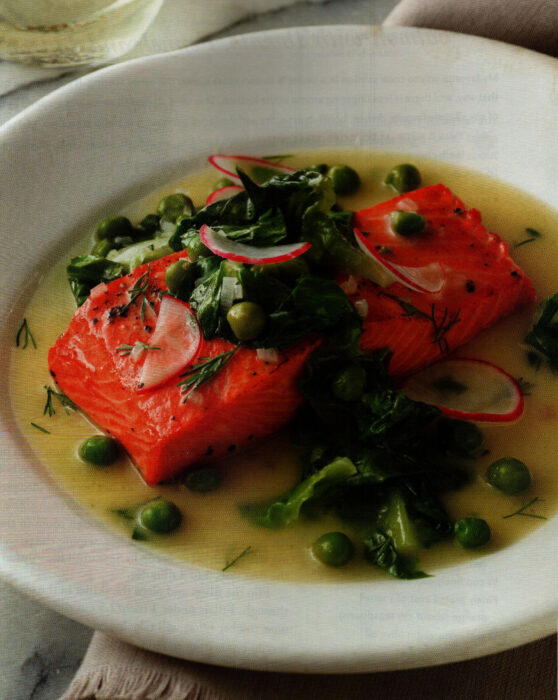
I just published a review of Searing Inspiration, a most lovely cookbook. The book has a specific concept: cook a main course then keep the pan, add components, and fashion a sauce to transform it all to a feast. A feast for your eyes as well as your mouth. Searing Inspiration offers some of the best food photography you will ever encounter.
Here is the first recipe in the book. I often look at a book’s first recipe as a “test” of what is to come. This salmon passes the test with the highest possible marks. Often we associate “sauce” with “French.” Oh, this is French. Something that can, if you just close your eyes a bit and take a deep sniff, make you think you are back in Paris.
Salmon with Buttery French Pea and Lettuce Broth
Yield: serves 2 large or 4 modest
Ingredients:
- 1 to 1 ½ pounds wild salmon fillets
- Salt and finely ground white pepper
- 2 to 3 tablespoons all-purpose flour for dredging
- 1 tablespoon clarified butter or olive oil
- 2 tablespoons mince shallots
- ⅓ cup dry white wine
- ⅔ cup fish stock or low-sodium chicken stock
- ½ cup green peas
- 2 cups loosely packed chopped bibb lettuce
- 1 tablespoon minced fresh tender herbs, such as chives, tarragon, dill or chervil
- 2 tablespoons cold unsalted butter, cut into pats
- Thinly sliced radish for garnish
Preparation:
PREP
Rub your hand gently along the top of the salmon to check for bones. If any remain, pull them out with tweezers. The fish can be cut into individual fillets or left whole and served family-style, if it fits in the skillet. Pat the salmon dry and season generously with salt and white pepper. (Black pepper will leave specks that are unappealing in this dish.) Dredge the fish in the flour and pat off the excess.
SEAR
Heat a lidded sauté pan over medium-high heat. When it is hot, swirl in just enough butter to coat the bottom. Arrange the fish in the pan; if the fillet has been cut into pieces, make sure they are evenly spaced. The fish should sizzle the moment it hits the hot surface. (If there is not enough room in the pan for all of the pieces, cook them in batches, wiping the pan clean and starting with fresh butter as needed.) Sear until the salmon is golden brown on the first side, about 3 minutes. Lift the fish from the pan and place it browned side up on a clean plate or platter. (It will not be cooked through at this point.)
SAUCE
Discard the cooking fat and analyze the pan residue. Remove any unappealing bits. Cool the pan slightly, then return it to medium heat. Add some more butter if the pan is very dry. Add the shallots and sauté until they have softened but not browned, about a minute. Deglaze the pan with the wine and use a wooden spoon to dissolve any residue on the bottom of the pan. Increase the heat slightly and simmer until the aroma of raw alcohol is gone and the volume is reduced by half
Return the fish and any accumulated juices to the skillet and add the stock. Cover and simmer gently until the fish is just cooked through; it should start to flake but still be slightly translucent in the center. Fillets that are 1 inch/2.5 cm thick should take only 3 to 4 minutes; thicker fillets will take a bit longer. The fish will continue to cook slightly as it rests. Lift the fish from the cooking liquid and arrange on a serving platter that will hold a thin, brothy sauce or in shallow bowls.
Simmer the cooking liquid for a minute longer to concentrate the flavors slightly. Add the peas. If you are using fresh peas, they will need about 2 minutes to cook through; if you are using frozen peas, heat them only long enough to take the chill off. Ade the chopped lettuce and herbs and stir until the lettuce just wilted, about 30 seconds. Be careful not to overcook it; the lettuce will continue to soften in the warm sauce. Stir in the butter a few pieces at a time until just liquefied; do not boil the sauce after the butter has been added. Taste and adjust the seasoning with additional salt and pepper as needed.
Spoon the vegetables and sauce over the fish, garnish with radishes, and serve immediately.
Source: Searing Inspiration by Susan Volland [Norton, 2018]
